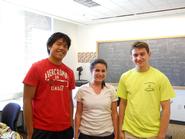
Influenza viruses spread quickly, are quite common and can have devastating consequences. Thus, drugs that help restrict the spread of influenza not only shorten the sickness, but save lives. This summer Daniel Mermelstein ’14, Carmen Montagnon ’13 and Alvin Wu ’13 are conducting research under Assistant Professor of Chemistry Adam Van Wynsberghe to examine the chemical interactions that these important drugs rely on to combat the flu.
Mermelstein’s summer research was funded through the Edward and Virginia Taylor Fund for Student/Faculty Research in Chemistry, established in 2008 through a gift from Ted ’46 and Virginia to inspire students interested in chemical research and to facilitate their work with outstanding faculty.
Influenza viruses attach to a host cell via the virus surface protein, hemagglutinin, which binds to sialic acid on the host cell’s surface. Once the virus has multiplied, new virus particles need a way to leave the host cell and find new, healthy cells to infect. The process of detaching a virus from a host cell relies on neuraminidase, another virus surface protein. Neuraminidase cleaves the sialic acid group from the host cell, separating the virus particle from the host. Consequently, drugs that inhibit neuraminidase slow the spread of influenza.
The students are working with two computer simulation methods, molecular dynamics and Brownian dynamics to analyze neuraminidase-sialic acid interactions. Both methods allow researchers to investigate biomolecular motion and interactions without having to execute anything in a lab. While Brownian dynamics allow for simulations to be carried out on a larger time scale, these simulations are generally less accurate than molecular dynamics. Molecular dynamics, on the other hand, are extremely accurate but would be inefficient on a larger scale.
The drug Oseltamivir, better known by its trade name, Tamiflu, blocks sialic acid binding sites on neuraminidase so that this protein cannot interact with a sialic acid group on the host cell surface and more cells do not become infected with the virus. Neuraminidase has two binding sites, the active and secondary sites, both of which interact with Tamiflu. While the active site is most clearly involved with sialic acid cleavage, the secondary site also interacts with sialic acid, though it remains unclear what exactly this site does. Montagnon is using Brownian dynamics to compare the association rates of Tamiflu to each binding site, essentially measuring how often the two molecules will collide in such a way that produces an interaction.
Wu is working with molecular dynamics. He is automating molecular dynamics simulations so that given the positions of a particular ligand and protein, the program can provide results without extensive human intervention. In this case, the ligand is sialic acid and the protein is neuraminidase. Wu’s project involves a lot of computer scripting and programming, as he is developing the program himself. When the program is completed he plans to run some simulations to test its reliability.
Mermelstein is analyzing previous data and integrating the two simulation methods to better understand the binding process. He is working with the results from Jeremy Adelman’s ’13 previous simulations of sialic acid-neuraminidase interactions to see if there are certain areas in neuraminidase’s structure that are particularly attractive to sialic acid molecules. To combine Brownian and molecular dynamics, Memelstein looks at the interaction in terms of the length of space between the neuraminidase and the sialic acid. As the two molecules near one another, there comes a point at which switching from Brownian to molecular dynamics would make for a more effective analysis. Mermelstein is attempting to locate this point in time so that future simulations of this reaction would give the most informative and accurate results.
Viral neuraminidase plays a vital role in the spread of influenza infection, and by restricting its functions researchers can develop drugs to fight the virus. Tamiflu, for example, was used last year to prevent the spread of H1N1. By researching the chemical interaction that Tamiflu deals with, these student researchers are aiding in the effort to slow influenza infection.
Daniel Mermelstein is a graduate of Vestal High School (N.Y.); Carmen Montagnon graduated from Acalanes High School in Lafayette, Calif. ; Alvin Wu is a graduate of Hopkins School in New Haven, Conn.
Posted July 24, 2011
